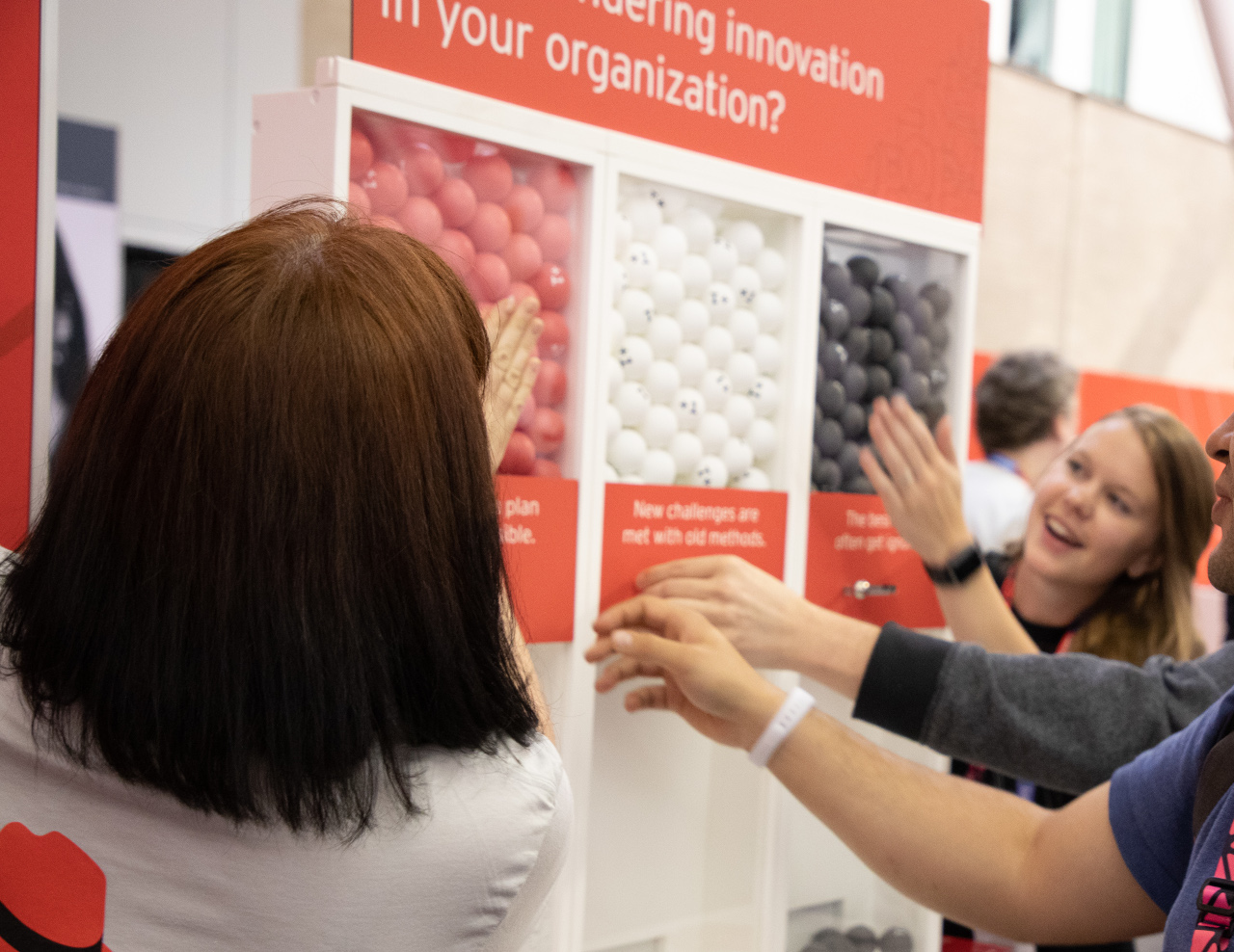红帽博客
Open tools work best in the hands of open people. At Red Hat, we understand that tackling bold challenges—like digital transformation or application modernization—requires more than technology alone. It requires new ways of thinking, working, and problem-solving. That's why we're committed to helping organizations understand how they can embrace open principles to reshape their organizational cultures in productive and innovative ways.
So for Red Hat Summit in Boston, MA this year, members of the Open Organization community wanted to craft a unique experience that would help attendees understand the power of working openly. We wanted to create opportunities for visitors to share their culture- and process-focused challenges with us—not only so we could learn more about what's keeping people from being as innovative, agile and engaged as they'd like to be, but also so we could connect them with resources they could use to begin tackling those challenges.
This is the story of what we did, how we did it, and what we learned.
What we did
The expo hall at Red Hat Summit is a buzzing place. We needed to build something that would spark conversation with just a moment's engagement.
And that made us think of the humble "+1." Sending a "+1" in an email or chat thread is a fast and easy way to contribute one's sentiment—just what we were looking for. So we brought the "+1" to life in physical form.
We designed an interactive installation that would allow an attendee to "+1" some culture-focused scenarios we described with a quick swipe. Printed on the front of the installation, these scenarios included things like: "poor communication hampers collaboration" and "people address new challenges with old methods." As the "+1s" rolled in on ping-pong balls, the installation became a visual representation of the pain points that resonated most with attendees. As other visitors walked by, they could see they weren't alone; others were facing the very same organizational challenges.

Even better: The activity jump-started deeper conversations about the specific experiences people were having and allowed us to learn a great deal about what was hindering innovation, agility, and engagement in their organizations.
Lessons learned
Here are three lessons we learned through conversations with dozens of visitors.
1. Shared goals matter more than shared titles.
Research can reveal quite a bit, but when it comes to learning from peers, nothing beats face-to-face conversations.
But what do we mean by "peers?"
Attendees cared less about job titles and more about shared challenges when seeking people who could offer advice. People who visited us perceived themselves not, for example, as a "senior manager" or a "chief architect," but more like "someone trying to get my teams to work more closely together," or "someone helping my teammates get more comfortable with change." They saw their challenges cut across formal hierarchies—and they sought advice in the same horizontal fashion.
2. Internal resources are the default.
Visitors didn't skimp on the details. They told us (in great and unashamed detail) about all the ways they felt their teams weren't collaborating as often as they should be, weren't communicating as inclusively as they needed to be, and weren't sharing as transparently as they could be.
We empathize. So we asked them how they were coping.
Some told us they sought the advice of trusted mentors and confidants in the organization, people with whom they could have candid conversations about what was ailing their teams. Those conversations, they told us, are invaluable.
Others said they searched for advice in their organizations' knowledge commons: an intranet or wiki or other internal location they knew they could find resources for getting their teams on the right track.
This taught us two very important lessons: Conversations are key, and we could help by creating additional materials for facilitating those tough and honest dialogues. And we needed to figure out how to link the open organization community's materials with those other resources available in repositories around the globe.
3. It's personal.
Organizational culture change begins and ends with concrete practice, the stuff people do every day and the spirit in which they do it. So organizational culture won't change until people commit to changing the ways they work together.
But no one enjoys feeling like their everyday behaviors—the default actions that come so naturally we never even stop to think about them—are being critiqued. We noticed several visitors turned skeptical (some even balked a bit!) if they got the impression we were telling them that their preferences and habits were harming their organizations.
We realized quickly that we needed to initiate conversations not by talking about what individuals were doing, but rather with the problems an organization was experiencing—and then exploring how adopting more open practices might help solve those problems. This made our interactions much more productive; visitors said they felt like they were changing their behaviors in the service of a higher purpose, not just because they were working in a way someone else "didn't like."
What's next?
Now that we've returned (and rested!), we're working to synthesize and catalog the most common themes that emerged from attendees' stories. Soon we'll be ready to share them with the rest of the Open Organization community and anyone else interested in creating open organizational cultures—so the conversation can continue.
Creativity is the code
The Open Organization is a Red Hat-supported project powered by the Open Studio, Red Hat's internal creative community—a team of marketing strategists, designers, writers, artists, filmmakers, developers, and communication specialists united by a singular purpose: to marry creative practice with disciplined research and analysis in order to tell authentic and compelling stories about the power of the open source way.
Guiding everything we do is a simple methodology: Listen. Learn. Build. Share.
We connect with Red Hat customers and partners to explore both their challenges and triumphs (listen), analyze what we hear and situate our findings in a broader context of market research and industry trends (learn), create artifacts and experiences that crystallize and magnify those discoveries (build), and re-connect those creations with audiences we hope can learn from and be inspired by them (share).
It's really fun.
Interested in learning more? Join the conversation on Twitter using hashtags #TheOpenOrg and #RedHatOpenStudio.
关于作者
Bryan Behrenshausen is a community architect in the Open Source Program Office at Red Hat.

